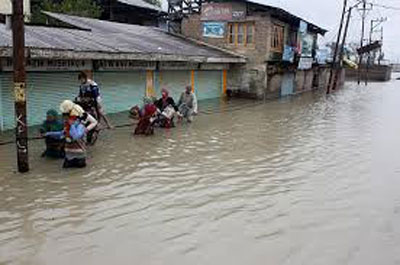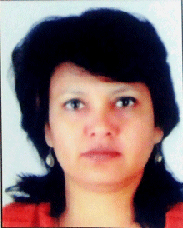 Srinagar:
Srinagar: Emergency workers battled on Monday to prevent waterborne diseases from spreading, as fetid water swilled around the Kashmir valley more than a week after the region's worst flooding in more than a century.
More than 75,000 people were still stuck in partly submerged homes in Kashmir's main city of Srinagar, where roads have been transformed into stagnant canals strewn with sewage, wreckage and dead livestock.
"Floating carcasses have become a big source of worry with most houses still waterlogged. We are struggling to get in touch with government health officials," said Abul Syed Rahman, who owns three hotels in Kashmir.
Both the Indian and Pakistani sides of the disputed Himalayan region have seen extensive flooding this month with Srinagar particularly hard hit.
Flooding and landslides have killed hundreds of people and tens of thousands are homeless. The cost of damage in Kashmir may run into billions of dollars.
The central government said it feared a rise in the number of people getting sick from dirty water and had delivered 25 water filtration plants with the capacity to filter 400,000 litres a day, and 13 tonnes of water purification tablets.
More than 200,000 people have been rescued in the past eight days and communication networks partially restored.
"Finally, we are seeing some government officials trying to restore basic services. In the last eight days we had no help from the government," said Alam Wani, a Srinagar bank official.
Wani's two-storey house has been partially submerged since the onset of torrential rain, forcing him to move into a mosque with his family of eight.
Hospitals were themselves hit by flooding when the swollen Jhelum river burst its banks, with staff scattered around the city and unable to get to work.
Doctors were running out of medicines and surgical equipment as they struggled to provide emergency services in makeshift medical centres.
"Our medical headquarters is totally under water. It is very difficult to deal with critical cases. Thousands of patients need antibiotics and diabetics require insulin," Dr Hina Rahman told Reuters.
Doctors warned that getting waterlogged hospitals working again would be tough because basement store rooms were flooded and expensive equipment like magnetic resonance imaging (MRI) and X-ray machines ruined.
People have been coming in with respiratory infections and gastric problems, said Zubair Khwaja, a doctor who normally works at Sher-i-Kashmir Institute of Medical Sciences but has been volunteering with the Muslim Students Board, a group that runs a religious school in Srinagar.
Municipal authorities said they had started collecting rubbish from pools of stagnant water and the fire department was using fire engines to pump out waterlogged areas.
The stench of rotting carcasses of cattle was almost unbearable for people in some parts of Srinagar, a city of more than a million people.
With acres of stagnant water remaining in the city, Khwaja warned that the risk of waterborne diseases would increase. "You can smell the air," he said.
Meanwhile the armed forces and the NDRF have rescued over 226,000 flood-hit people in Jammu and Kashmir as relief efforts continued in the state Monday.
The defence ministry, however, warned that water-borne diseases could break out as the flood waters recede.
More than 200 people have died in the worst flooding in half a century in the Kashmir Valley. Officials admit that the figure could be higher because communication with remote areas has snapped.
A defence ministry statement said the demand for filtered water had gone up all over Jammu and Kashmir, particularly in the valley.
Twenty RO (reverse osmosis) plants with a capacity to filter four lakh litres a day and four RO plants with a capacity to filter one lakh litres a day were being sent to Srinagar, the statement said.
Besides water purifying tablets and water filtration plants, heavy duty suction and sewage pumps were also being flown to Srinagar.
"Generator sets have been sent to Srinagar to augment continuous power supply in relief camps and field hospitals.
"Additional communication equipment of BSNL are being dispatched to restore the communication systems in the state."
More than 508,000 litres of water and over 1,054 tonnes of food packets and cooked food have already been distributed in the flood-affected areas.
Rescuers have also distributed 8,200 blankets and 1,572 tents.
Besides 80 medical teams, four army field hospitals have been established. Till now they had treated around 53,082 patients.
Additionally, two additional fully equipped field hospitals with laboratory testing equipment facility have been established in Srinagar.
A rapid action medical team from the air force had been deployed at Avantipur and Srinagar.
More relief materials including tents, water bottles and food packets were being airlifted from Delhi and Amritsar.
So far, 80 transport aircraft and helicopters of the Indian Air Force and Army Aviation Corps have been pressed into service.
The army has deployed around 30,000 troops for rescue and relief work.
A total of 2,451 sorties have been undertaken by the helicopters and aircraft of armed forces, and 3,435 tonnes of relief materials have been dropped by the air force.
Some 220 army boats and 148 inflatable boats of the National Disaster Response Force are involved in rescuing people still marooned in flood waters.
To restore road connectivity, some 5,700 personnel of the Border Roads Organisation have been pressed into service.
 Srinagar: Emergency workers battled on Monday to prevent waterborne diseases from spreading, as fetid water swilled around the Kashmir valley more than a week after the region's worst flooding in more than a century.
Srinagar: Emergency workers battled on Monday to prevent waterborne diseases from spreading, as fetid water swilled around the Kashmir valley more than a week after the region's worst flooding in more than a century.